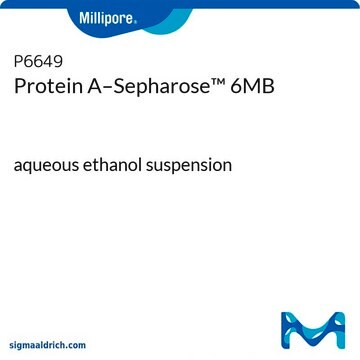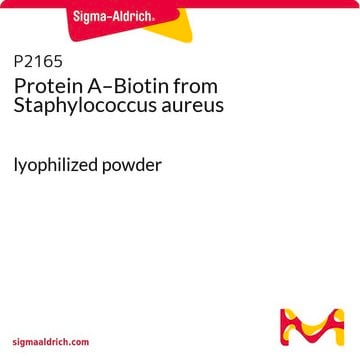P1406
Protein A–Agarose
lyophilized powder
Sinonimo/i:
Protein A resin
About This Item
Prodotti consigliati
Forma fisica
lyophilized powder
Grado di funzionalizzazione
~2 mg per mL
Matrice
Cross-linked 4% beaded agarose
Attivazione matrice
cyanogen bromide
Gruppi immobilizzati alla matrice
amino
Braccio spaziatore
1 atom
Capacità
≥15 mg/mL binding capacity (human IgG)
Temperatura di conservazione
−20°C
Cerchi prodotti simili? Visita Guida al confronto tra prodotti
Categorie correlate
Applicazioni
Quantità
Stato fisico
Avvertenze
Danger
Indicazioni di pericolo
Classi di pericolo
Eye Dam. 1 - Skin Corr. 1B - STOT SE 3
Organi bersaglio
Respiratory system
Codice della classe di stoccaggio
8A - Combustible corrosive hazardous materials
Classe di pericolosità dell'acqua (WGK)
WGK 3
Punto d’infiammabilità (°F)
Not applicable
Punto d’infiammabilità (°C)
Not applicable
Dispositivi di protezione individuale
Eyeshields, Gloves, type N95 (US)
Certificati d'analisi (COA)
Cerca il Certificati d'analisi (COA) digitando il numero di lotto/batch corrispondente. I numeri di lotto o di batch sono stampati sull'etichetta dei prodotti dopo la parola ‘Lotto’ o ‘Batch’.
Possiedi già questo prodotto?
I documenti relativi ai prodotti acquistati recentemente sono disponibili nell’Archivio dei documenti.
I clienti hanno visto anche
Contenuto correlato
Access high-quality reagents for antibody workflows, including adjuvants, blocking reagents, conjugation kits, and more.
Il team dei nostri ricercatori vanta grande esperienza in tutte le aree della ricerca quali Life Science, scienza dei materiali, sintesi chimica, cromatografia, discipline analitiche, ecc..
Contatta l'Assistenza Tecnica.












